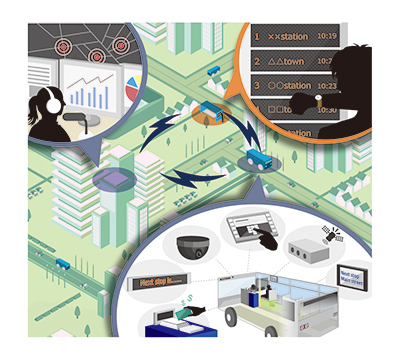Fleet Management System /Passenger Information System
What are Fleet Management Systems ?
- Transit Management System (TMS)& Passenger Information System (PIS)
- Fleet Management for Public Transportation
Best-in-Breed Solution
NEC's TMS is an advanced public transportation fleet management system that presents transit agencies (and Public Transport Operators) with effective, data-powered tools for vehicle and fleet planning, measuring performance, streamlining operations, monitoring of fleet location and delivering new and improved services.
This system is a true multi-tasking and multi-user environment with capabilities to monitor, supervise and control operations with real-time data. It incorporates several solutions:
Service performance and planning management – efficiency of transit operations is monitored and reported, namely emphasis is put on route and schedule adherence monitoring, excess wait time monitoring with the goal to improve the on time transit performance and service regularity
Incident management – real time incident management, enabling Service Controllers to make informed decisions and timely responses to voice or data messages (emergency, PRTT, PTT, BTT request) and have the overall picture how the entire bus fleet or a portion is performing
Data Analysis - the TMS system components produce large amounts lot of data of transit performance and event data in a very short time. As a result, it is important for associated analysis tools to have the capacity to process and interpret these large volumes of data to support service performance and patronage reporting. The possibilities for deriving valuable information from these data are virtually unlimited and represent a critical element of a public transport support infrastructure
Feature
- Real time Passenger Information System (PIS)
The most fundamental element for a real time bus information service for passengers is accurate Expected Time of Arrival (ETA) prediction. NEC’s real time prediction engine is based on multi-dimensional statistics that provide stable ETA prediction and addresses variables such as day, time of the day, route type, schedule type, dwell time, travel time, etc.
ETA Data is available through standard SIRI and GTFS Real Time formats. - On Board Visual and Audio Annunciation (AVAS)
In-vehicle solution and supports multi-language audio and text announcements. The announcement sequence is defined for each unique route path. The OBC determines bus status, monitors the progress of the bus on the route, calculates the distance on service route, detects any route deviation and then triggers the correct audio and visual annunciations for every route and stop. - Real Time Data Analysis and Management Platform
Efficiency of transit services and operations are monitored in real time, with emphasis on route adherence and schedule adherence monitoring, excess wait time monitoring - Bus Routing and Trip Assignment
Multiple modes of route/trip selection for both Scheduled Trips as well as Dynamic (ad-hoc) Trips are supported. - Business Intelligence
Best in class business intelligence and visualization tools fully embedded into the TMS application along with entire data set and user management. The Business Intelligence (BI) dashboards and reports are driven from centralized data and provide decision support tools that increase operational efficiencies and reduce costs.
Expected effects
- Transport Authorities
Transit authorities gain a complete overview of service performance in a form that allow them to manage and improve service delivery and customer experience. - Transport Operators
Operators can streamline operations, expedite decisions, increase passenger services and safeguard assets while transforming public transit operations into service-centric environments that take on a proactive role in managing, monitoring and mitigating issues through the transit system by providing real-time visualization of transportation operations. - Riders
Riders are put back in the center of the service with a customer-experience-focused service management platform. Improved accessibility to necessary information gives riders more choice about how to use a service and builds trust in that service.
Conceptual illustration of What is Fleet Management System /Passenger Information System

Case Studies
City Bus Limited, Hong Kong, (1,700 buses)
- AVAS in harshest environment (HK largest high-rise city in the world)
- AVL & CAD
- Passenger Information System (PIS)
- ETA engine and data dissemination (SMS, Web page with CTB branding)
- Data logging based on Transport Department certification
- Integration with proprietary mapping, schedule, bus dispatching system and content management tools